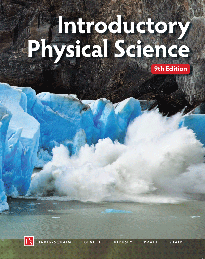 Introductory Physical Science (IPS)
Introductory Physical Science (IPS)
9th Edition
Table of Contents for IPS-9
PROPERTIES OF MATTER
Chapter 1 - Volume and Mass
Experiment: Heating Baking Soda
Volume
Reading Scales
Experiment: Measuring Volume by Displacement of Water
Limitations of Volume as a Measure of Matter
Mass: The Equal-Arm Balance
Single-Pan and Electronic Balances
Experiment: The Sensitivity of a Balance
Chapter 2 - Mass Changes in Closed Systems
Experiment: The Mass of Dissolved Salt
Histograms
Using a Computer to Draw Histograms
Experiment: The Mass of Ice and Water
Experiment: The Mass of Copper and Sulfur
Experiment: The Mass of a Gas
Conservation of Mass
Laws of Nature
Chapter 3 - Characteristic Properties
Properties of Substances and Properties of Objects
Experiment: Mass and Volume
Density
Dividing and Multiplying Measured Numbers
Experiment: The Density of a Solid
Experiment: The Density of a Liquid
Experiment: The Density of a Gas
The Range of Densities
Experiment: Freezing and Melting
Graphing
Experiment: Boiling Point
Boiling Point and Air Pressure
Distinguishing Substances
Chapter 4 - Solubility
Experiment: Dissolving a Solid in Water
Concentration
Experiment: Comparing the Concentrations of Saturated Solutions
Experiment: The Effect of Temperature on Solubility
Wood Alcohol and Grain Alcohol
Experiment: Isopropanol as a Solvent
Experiment: The Solubility of Carbon Dioxide
The Solubility of Gases
Acid Rain and Global Warming
Drinking Water
Chapter 5 - The Separation of Mixtures
Experiment: Fractional Distillation
Petroleum
The Separation of Insoluble Solids
Experiment: The Separation of a Mixture of Solids
Separation of a Mixture of Soluble Solids
Experiment: Paper Chromatography
Mixtures Involving Gases
Mixtures and Pure Substances
Chapter 6 - Compounds and Elements
Decomposing Pure Substances
Experiment: The Decomposition of Water
The Synthesis of Water
Experiment: The Synthesis of Zinc Chloride
The Law of Constant Proportions
Experiment: A Reaction with Copper
Experiment: The Separation of a Mixture of Copper Oxide and Copper
Complete and Incomplete Reactions
Experiment: Precipitating Copper
Elements
Elements near the Surface of the Earth
ATOMS AND MOLECULES
Chapter 7 - Radioactivity
Radioactive Elements
Radioactive Decomposition
Experiment: Radioactive Background
Experiment: Collecting Radioactive Material on a Filter
Experiment: Absorption and Decay
A Closer Look at Radioactivity
Radioactivity and Health
Chapter 8 - The Atomic Model of Matter
A Model
Experiment: A Black Box
The Atomic Model of Matter
"Experiment": Constant Composition Using Fasteners and Rings
Constant Proportions and the Atomic Model
Experiment: Flame Tests of Some Elements
Experiment: Spectra of Some Elements
Spectral Analysis
"Experiment": An Analog for Radioactive Decay
Half-Life
Chapter 9 - Molecular Motion
Molecular Motion and Diffusion
Number of Molecules and Pressure of a Gas
A Prediction about the Relation between Volume and Pressure of Gases
The Compressibility of Gases
Temperature and Molecular Speed
Avogadro's Law
Masses of Atoms and Molecules
Behavior of Gases at High Pressures
Chapter 10 - Classification of Elements: Periodic Table
A Historical Sketch
Some Families of Elements
Activity: Atomic Mass and Other Properties of Atoms
Elements in the Third Through Sixth Columns
Activity: The Elements in the Fourth Row
The Fourth and Fifth Rows: A Historical Perspective
Chapter 11 - Sizes and Masses of Molecules and Atoms
The Thickness of a Thin Layer
Experiment: The Thickness of a Thin Sheet of Metal
Experiment: The Size and Mass of an Oleic Acid Molecule
The Mass of Helium Atoms
The Mass of Polonium Atoms
ENERGY AND FORCES
Chapter 12 - Heating and Cooling
Introduction
Experiment: Mixing Warm and Cool Water
A Unit of Energy: The Joule
Experiment: Cooling a Warm Solid in Cool Water
Specific Heats of Different Substances
Experiment: Melting Ice
Heat of Fusion and Heat of Vaporization
Experiment: Heat of Reaction
Comparing the Energies Involved in Different Reactions
Chapter 13 - Potential Energy and Kinetic Energy
Experiment: Heating Produced by a Slowly Falling Object
Gravitational Potential Energy
Kinetic Energy
Kinetic Energy as a Function of Speed
Experiment: Changing Gravitational Potential Energy to Kinetic Energy
The Law of Conservation of Energy
Chapter 14 - Forces
Introduction
Weight: the Gravitational Force
Activity: The Elastic Force: Hooke's Law
Experiment: The Magnetic Force
Experiment: Sliding Friction
Friction and Weight
Newton's Third Law
Chapter 15 - Forces Acting in Different Directions
Balanced Forces on a Line
Representing Forces in a Plane
Experiment: Balanced Forces in a Plane
The Net Force
Forces and Their Components
Experiment: Forces Acting on Moving Objects
Newton's First Law
Chapter 16 - Forces and Motion in a Straight Line
Experiment: The Motion Detector
Velocity Graphs
Experiment: Motion under a Constant Net Force: The Effect of Time
Experiment: Motion under a Constant Net Force: The Effect of the Magnitude of the Force
Free Fall and the Effect of Mass: A Prediction
Experiment: Testing a Prediction: The Relation Between Mass and Change in Velocity
Newton's Second Law
Appendices
Calculating in Scientific Notation
Proportionality
Available: Now

The new 9th Edition of Introductory Physical Science (IPS) continues the IPS tradition of guiding students to knowledge of physical science and the way scientific knowledge is acquired.
Inspect the table of contents and more details on our new edition of IPS.
